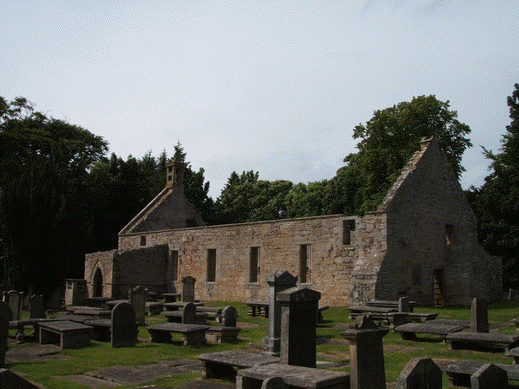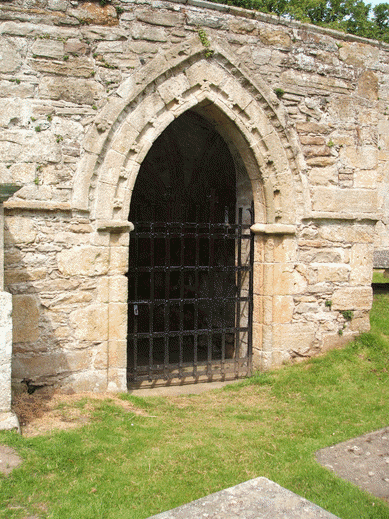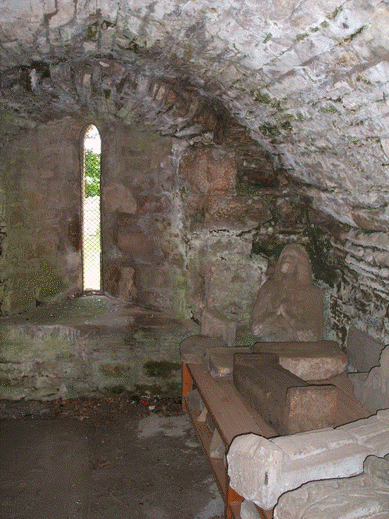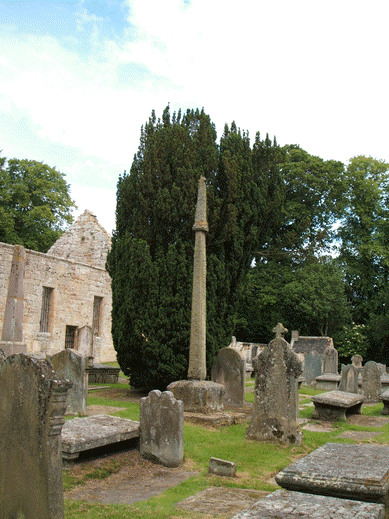 |
Duffus |
 |
 |
Duffus |
 |
Associated Chapels: Unthank; Burghead; Roseisle; St Lawrence.
OS Ref: NJ 175687 RCAHMS No: NJ16NE 2
St Peter's Church at Duffus was in existence in the days of Bishop Simon de Tonei (1171x1184) but is possibly situated on the site of an older foundation. {Duffus - 'Dubh-uis'; black or stagnating water.} In medieval times the church was a part of the Deanery of Elgin.

The medieval portions which survive consist of the barrel-vaulted base of a western tower (now a Sutherland burial vault), and a porch with groined vault on the south side. The latter, a beautiful fragment, is possibly one of the oldest relics of ecclesiastical architecture in the province. The remainder of the medieval structure was replaced by an 18th century 'improvement'.
 |
 |
|
16th Century porch with groined vaulting. |
The Sutherland Vault with "the Angel" in the corner. |
There was a chapel dedicated to St Lawrence within the churchyard of St Peter's founded by Freskinus de Moravia, one of the Lords of Duffus, who was buried within it (c.1269) as were several of his ancestors. He endowed the chapel with the lands of Dalvey in Strathspey. Also, within the church, there was an 'altar of the blessed Katharine' near which Walter de Moravia, Hugh's son, was buried. In front of Duffus House (NJ 1750 6846) lies St Lawrence's Well (Chalybeate).
Hugh de Moravia, Lord of Duffus, was dead by 1226 and was buried within the Church of Duffus, near the altar of St Katharine. So was his son Walter. It appears that Hugh at least obtained the character of sanctity (if not actually beatified/canonised) for his benefactions to the Church in general. He had two sons - Walter, who succeeded him, and Andrew, who was Parson of Duffus during his father's lifetime and during the episcopate of Bishop Bricius, whom he succeeded as Bishop of Moray in 1222. Freskin, mentioned above, was Walter's son.
The oldest remaining 'remnant' is the porch which bears the arms of Alexander Sutherland (who married Morella Chisholm of Quarrelwood) thus dating it to to before 1479 - his tomb, giving this as the year of his death, is in the mausoleum at the east end of the church. Inside the porch is groined and the shield is placed at the meeting of the arches.
Andrew de Moravia, the founder of the Cathedral at Elgin, was a member of the famous family long associated with the Castle and, before becoming Bishop, was Parson of Duffus.
Duffus was from the earliest times a prebend of the cathedral. The patronage of the church was given to the Bishop of Moray in 1294 by Christina de Moravia.
Cowan and others say that there was a chapel dedicated to the BVM "at Unthank in this parish." Bishop Bricius foundd a chapel at Duffus Castle early in the 13th century. When Bishop Robert Hepburn added a new canonry and prebend to the Chapter in 1542 it was called Unthank and was said to comprise the chapel of the BVM within the castle of Duffus. The question remains as to whether there were two separate chapels or only one, that at the castle.
|
|
|
Ancient Duffus Castle - seat of the de Moravia family. |
For many years St Peter's has been the burial place of the Dunbar family, anciently Baronets of Northfield and related to the de Moravia family. The head of the family lives in the Old Manse, a little further along the road which leads to the world-famous Gordonstoun School, which has had a number of members of the British Royal Family as pupils.

Within the churchyard of St Peter's is also a medieval market cross (one of many to be found in Moray), a remnant of the days when the churchyard was used by the people of the parish for their weekly fairs. Sadly, the head of the cross is now missing but was probably highly decorated.
Besides the chapel of Unthank, there were chapels at Roseisle, and Burghead (St Aethan's) within this parish.

e-mail: admin@cushnieent.force9.co.uk
© 2005 Cushnie Enterprises